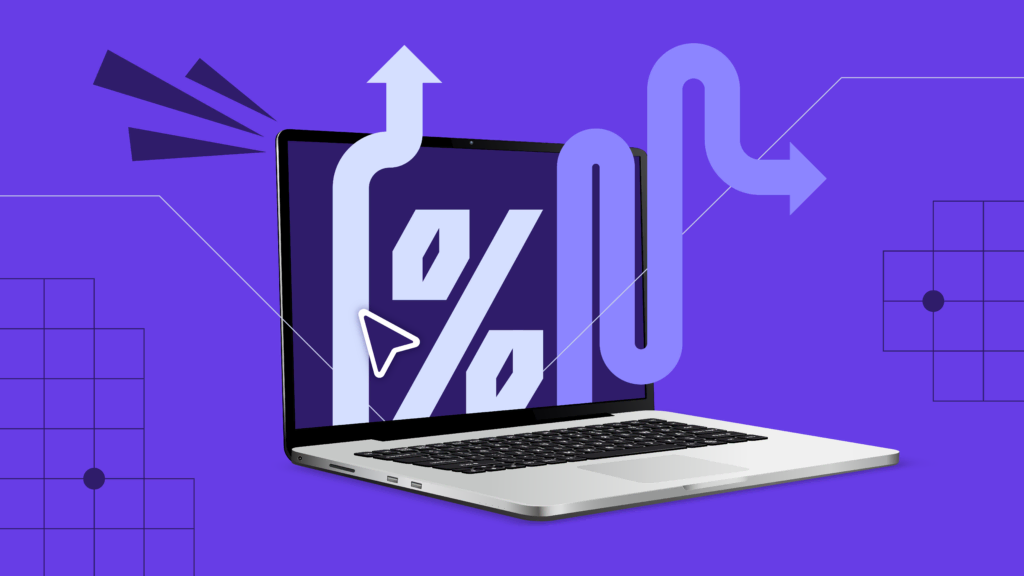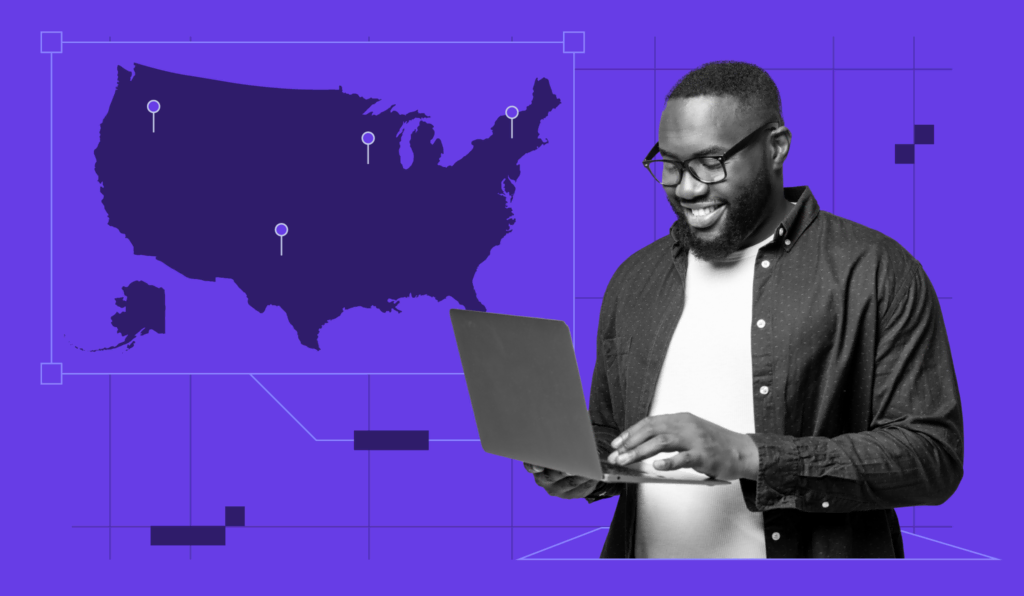Black Friday statistics 2024: Key consumer insights and shopping trends for the upcoming holiday season

Black Friday has long been a cornerstone of the global shopping calendar. In 2023, Black Friday sales in the U.S. totaled $9.8 billion. This year, projections indicate sales will reach $10.8 billion, a 9.9% increase from 2023. With both consumers and businesses eagerly preparing for massive sales, understanding shifting shopper habits is key for retailers to navigate this iconic event and make the most of it.
This article delves into the top Black Friday statistics and trends drawn from Hostinger’s survey in October 2024. We gathered responses from 1,000 US consumers about their shopping preferences, spending habits, and interest in products during Black Friday and Cyber Monday.
We considered demographic factors like age and gender, shopping modes, and marketing influences to provide a comprehensive view of the 2024 Black Friday shopping landscape.
Top Black Friday statistics
As we head into the Black Friday season, eCommerce shopping habits and spending trends continue to evolve, influenced by both economic conditions and technological advancements.
Here’s a breakdown of some of the key Black Friday statistics from this year’s survey:
- 31% of Americans plan to spend more this year. While most consumers will spend around the same as last year, 31% plan to increase their spending in 2024. Men are more likely than women to boost their Black Friday purchases as they hunt for the best Black Friday deals across both physical and online stores.
- Gen Z wants more but has less to spend. Despite enthusiasm for Black Friday, Gen Z has lower spending power compared to older generations, with their second most common spending range between $100 and $299.
- Hybrid shopping dominates, but online-only shoppers are rising. While 63.5% of respondents plan to shop both online and in-store, nearly 30% will stick to online-only shopping. Creating an online store with an easy-to-use platform, like the Hostinger Website Builder, can help businesses reach online-only shoppers more effectively.
- Mobile shopping is rising, but desktop shopping remains popular. 46.46% of shoppers plan to use their mobile phones for online purchases, while desktops follow closely behind at 44.85%. The preference for mobile shopping is more pronounced among younger generations.
- Product preferences vary by age. Baby Boomers are more interested in buying toys, likely for grandchildren, while Gen Z focuses on fashion and beauty. Electronics remain a top category across all age groups.
- Price is king, but convenience also matters. 62.2% of consumers say price is their top consideration when choosing where to shop. Younger generations place more importance on other factors like shipping speed and convenience.
- Email marketing drives purchases. Email remains the most influential marketing channel, with 59.2% of respondents stating it impacts their buying decisions. Social media ads also play a key role, particularly among younger shoppers.
- Impulse buying is common. A third of consumers buy items without planning during Black Friday, with women being the more impulsive gender and Gen Z the most impulsive generation.
31% of Americans plan to spend more this year
In 2024, 31.1% of Americans plan to spend more during Black Friday than last year. The majority of 49.3% anticipate spending about the same amount, while 17.3% of respondents expect to spend less this year.
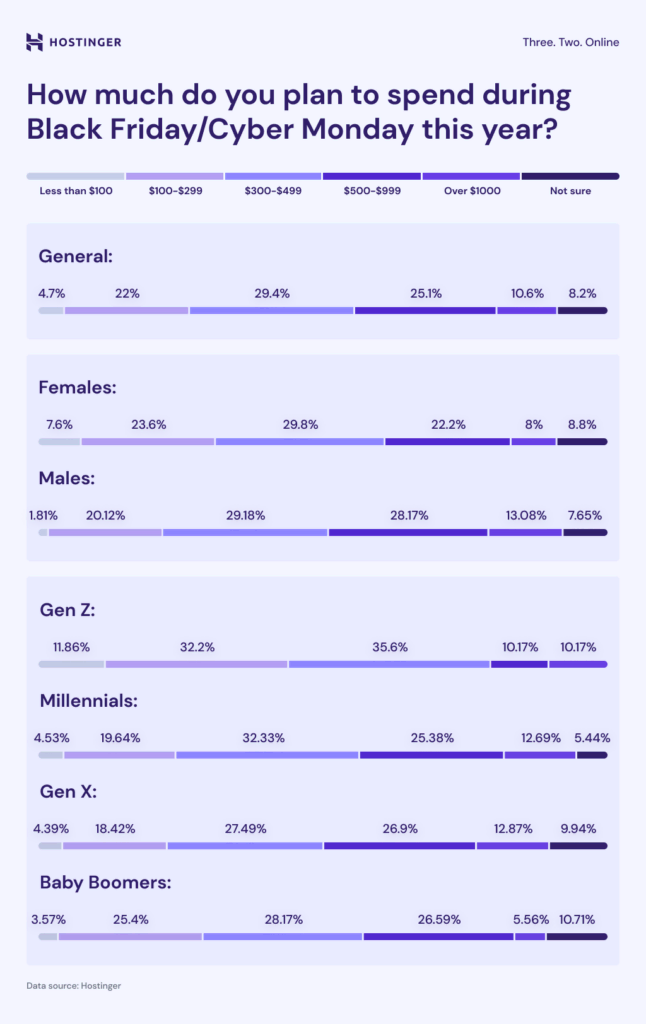
Most respondents (29.4%) plan to spend between $300 and $499, followed by 25.1% intending to spend $500 to $999. Around 22% aim to keep their spending between $100 and $299, while 10.6% plan to spend more than $1,000. Only 4.7% of shoppers expect to spend less than $100.
With consumers on the hunt for the best Black Friday deals, it’s crucial for businesses to make the most of this surge in spending.
If you want to launch or upgrade your online store this year, we recommend checking out the best Black Friday web hosting deals to secure premium web hosting services at a fraction of the cost.
Men intend to spend more than women
When looking at spending by gender, 36.22% of men plan to spend more this year, compared to 26% of women. This suggests men are generally more willing to increase their spending, while women are more careful with theirs.
Both men and women plan to spend between $300 and $499, but 28.17% of men intend to spend $500 to $999, compared to only 22.2% of women. Additionally, 13.08% of men expect to spend more than $1,000, while only 8% of women are planning to spend that much.
Gen Z wants more but spends less
Most Gen Z shoppers report they will spend more this year, however, their actual spending power remains lower than older generations.
While $300 to $499 is the most common spending range across all age groups, Gen Z’s second most common spending range is $100 to $299. In contrast, Millennials, Gen X, and Baby Boomers are more likely to spend between $500 and $999.
30% of Americans choose to buy online-only
In 2024, 63.5% of shoppers will use both online and in-store channels for their Black Friday purchases, showing a strong preference for a hybrid approach. However, nearly a third of respondents (29.7%) will shop exclusively online, while only 6.8% plan to shop solely in-store.
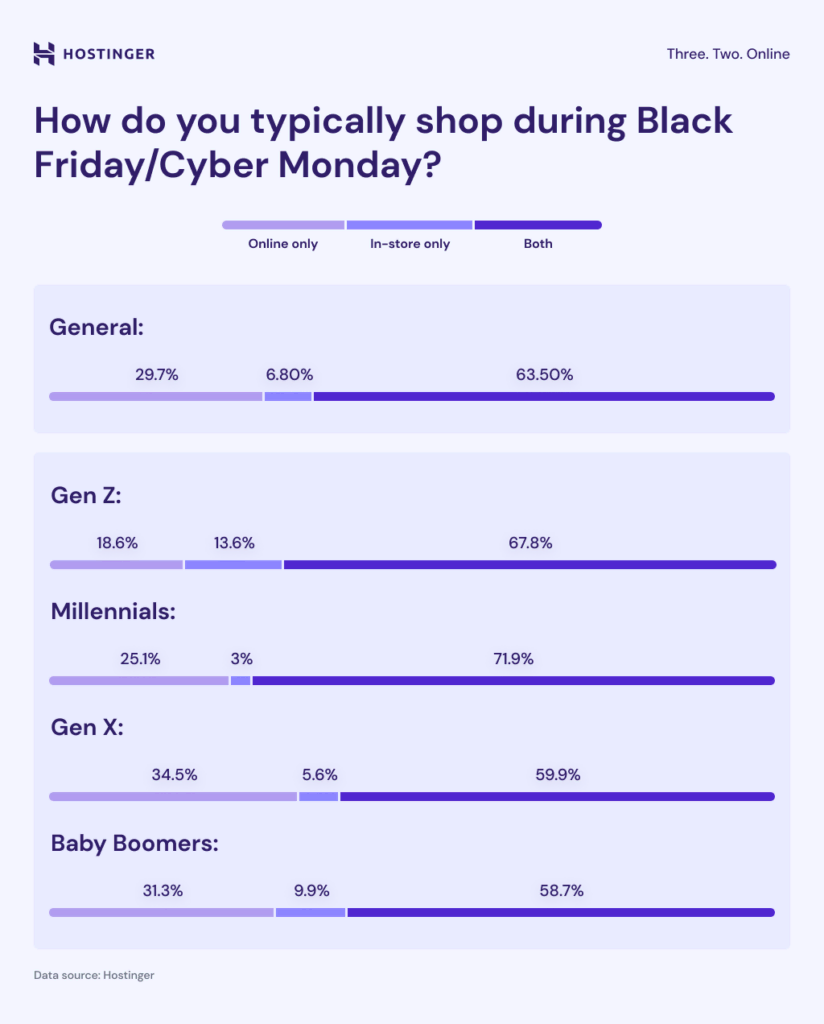
For businesses catering to this growing trend, having a robust and easy-to-build online presence is crucial. With tools like Hostinger AI Website Builder, even small businesses can quickly set up a professional-looking eCommerce store, perfect for the influx of online shoppers this Black Friday.
Interestingly, there is no significant difference between men and women in this shopping behavior. However, generationally, Millennials stand out with the smallest percentage of in-store-only buyers at just 1.3%. This highlights their reliance on online shopping.
Adapt to mobile, but don’t forget desktop shopping
When it comes to online shopping, 46.46% of respondents prefer using mobile phones, but desktops and laptops are still a close second at 44.85%. Tablets lag behind, with only 8.15% of shoppers favoring them.
Men tend to prefer desktops and laptops (45.27%) over mobile phones (41.65%). Similarly, Gen X and Baby Boomers also favor bigger screens (46.44% and 66.52%, respectively). The preference for mobile shopping is more pronounced among younger generations, though it is still a popular choice across all age groups.
For those building their eCommerce presence, ensuring your store is optimized for mobile can boost conversions. Follow our guide to learn how to make a website mobile-friendly.
Baby Boomers want kids’ toys – yes, that’s right

This year, Baby Boomers stand out for their interest in buying toys, more so than younger generations. This trend could be tied to the fact that many Baby Boomers are shopping for their grandchildren during Black Friday.
Younger generations, such as Gen Z, Millennials, and Gen X, still prioritize electronics on their shopping lists. While Gen Z is more focused on fashion and beauty products, Gen X leads in purchasing electronics.
Interestingly, Millennials show a preference for buying home appliances over beauty products, unlike Baby Boomers and Gen X, who favor beauty products over home appliances. This is likely because the older generations already have well-equipped homes.
Gen Z breaks the pattern
Overall, the majority of Black Friday shoppers are primarily interested in buying electronics (81.9%) and fashion/clothing (71.1%). However, there are clear gender differences, with 61.07% of men planning to buy electronics, compared to only 33.33% of women.
Gen Z breaks the mold by showing a stronger interest in fashion and clothes than electronics, making fashion their top category for Black Friday shopping. Their second most common purchase is electronics, followed by beauty products, unlike older generations who prioritize toys in third place.
For Millennials, Gen X, and Baby Boomers, electronics continue to dominate, followed by fashion and toys.
The old quality vs. price dilemma
When it comes to balancing price and quality during Black Friday shopping, there’s a noticeable difference between genders.
Women show more variability in how they weigh these two factors, with a clear preference for either the middle or top end of the scale (50 or 100). For men, however, the trend leans more heavily towards better value, indicating that they place a greater emphasis on quality but without a prominent preference for middle-range scores.
Visual 6 Females vs Males
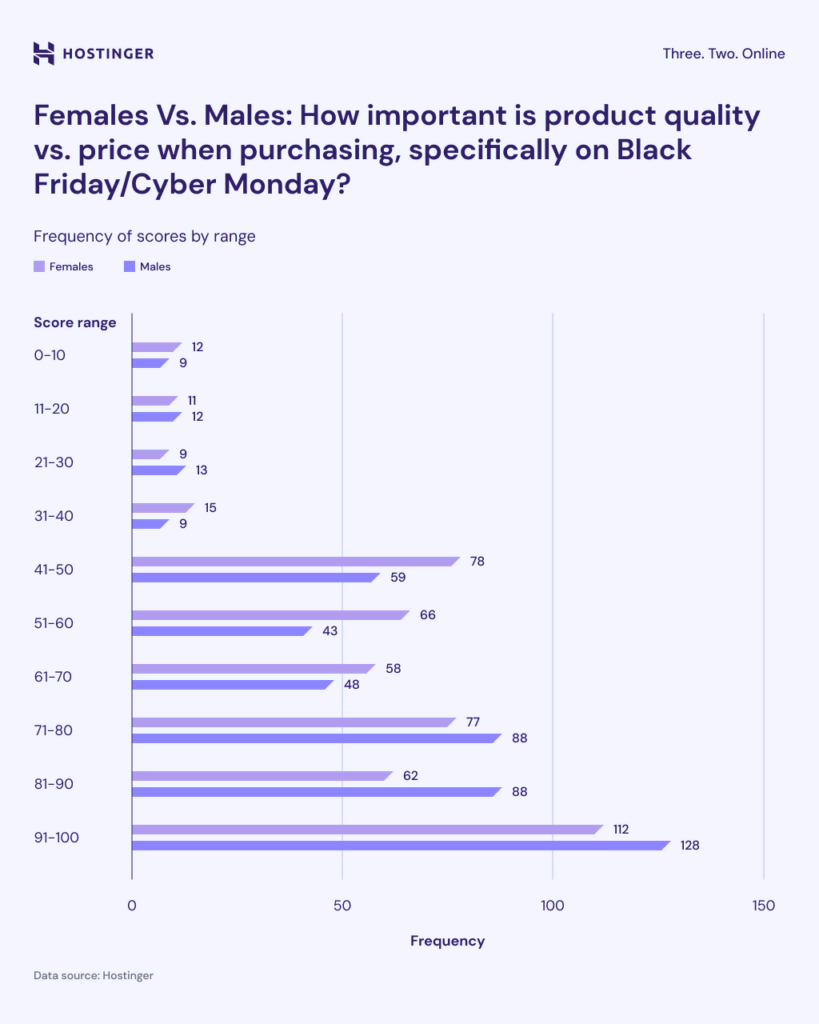
Generally, Gen X and Baby Boomers prioritize straightforward purchases over price-quality trade-offs, suggesting they’re less focused on optimizing value compared to younger shoppers.
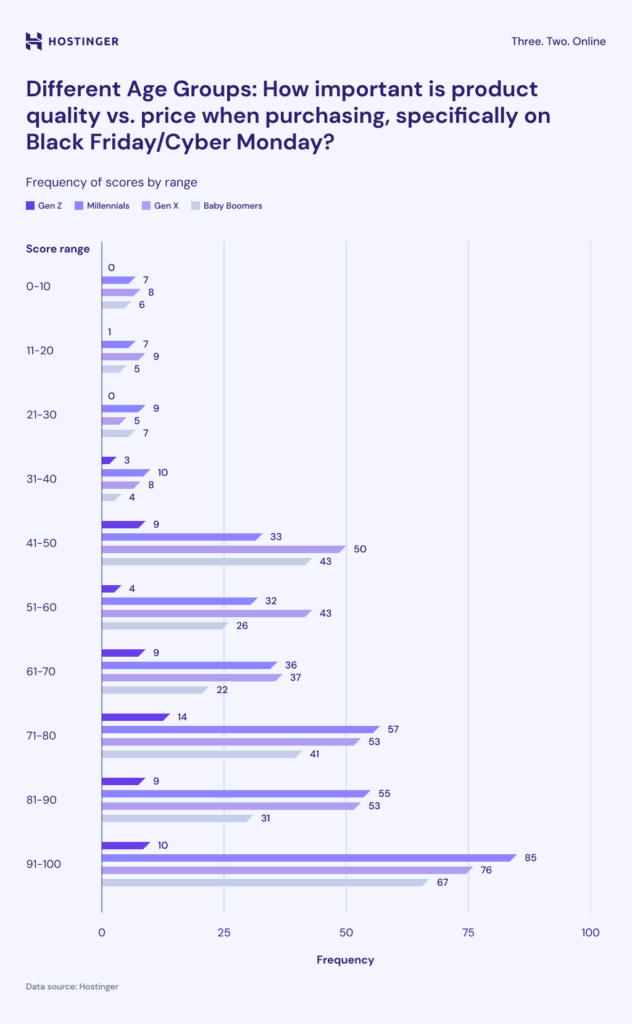
But price is (still) king
Despite varying attitudes toward quality, price remains the top consideration for most shoppers across generations. 62.2% of respondents said price is the most important factor when deciding where to shop during Black Friday.
Following price, 14.1% prioritize product availability, while convenience, shipping options, and brand reputation trail at lower percentages. Younger generations like Gen Z and Millennials rank shipping and convenience higher than Gen X and Baby Boomers, who place almost equal importance on brand reputation.
Gen X and Baby Boomers don’t care for bundle deals
Most respondents (67.9%) say that large discounts are the most enticing promotion during Black Friday, with 12.7% prioritizing free shipping.
For Gen X and Baby Boomers, bundle deals are the least important promotion type, while younger generations prefer them.
Interestingly, Gen Z ranks brand reputation as the least important factor when shopping, while for older generations, sustainability ranks the lowest.
Gen Z, the environmentally aware
Gen Z stands out for its environmental awareness, with 64.4% of respondents indicating that sustainability is an important factor when making purchasing decisions. This drops to 44.7% for Millennials, 35.7% for Gen X, and 29.0% for Baby Boomers.
The majority of Gen Z and Millennials scored above 50 in terms of how much they care about sustainability, while older generations like Gen X and Baby Boomers show a wider range of opinions, with many scoring below 50. Interestingly, women seem more willing to pay extra for sustainable products (40%) compared to men (36.6%).
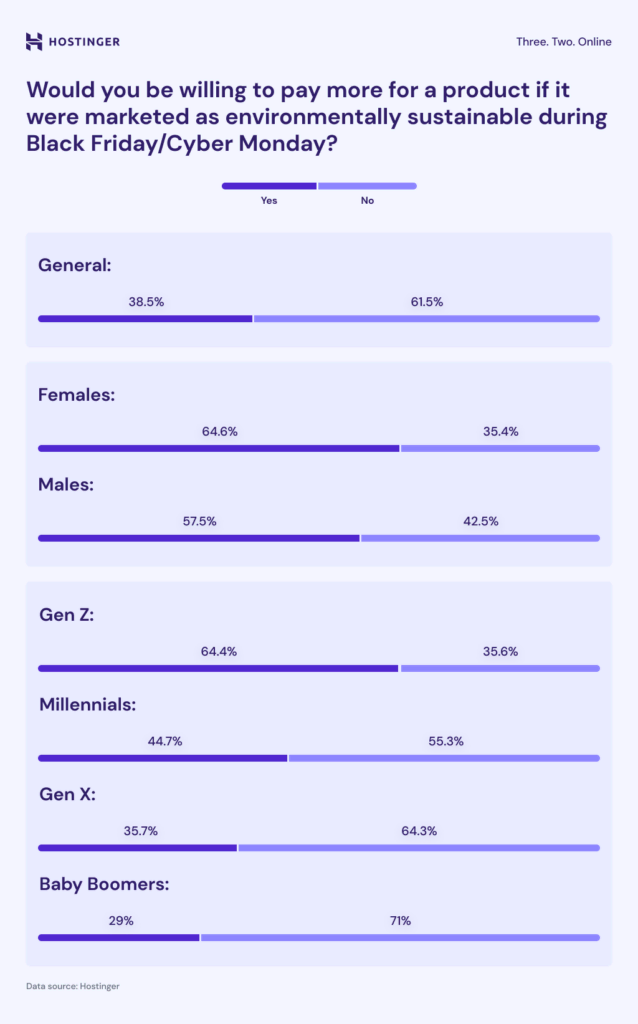
Most respondents, regardless of age, are not willing to pay significantly more for eco-friendly products. This willingness decreases with age, showing that younger consumers are more motivated by sustainability than their older counterparts.
84% of Americans say free shipping is key
For most shoppers, lack of free shipping is a dealbreaker when it comes to Black Friday purchases. According to the survey, 83.8% of respondents indicated that free shipping is the most important factor influencing their decision to complete a purchase.
Other shipping options, such as fast shipping (43.6%), free returns (38.1%), same-day delivery (23%), and store pickup (23.7%), are considerably less important. This trend holds true across both genders and all generations, making free shipping the dominant factor during Black Friday sales.
Gen Z wants faster shipping
While free shipping is important to all generations, Gen Z stands out for its preference for same-day delivery. For this younger group, same-day delivery ranks right after free shipping as the next most important option.
Gen Z is also willing to pay extra for faster shipping, a trend not seen in older generations. For example, Baby Boomers show little to no interest in paying more for quicker delivery, highlighting a generational divide in shipping preferences.
Baby Boomers want free returns
For Baby Boomers, free returns are a key consideration, ranking just behind free shipping. This differs from younger generations, who tend to prioritize fast or same-day delivery over free returns.
Same-day delivery is the least important option for Baby Boomers, further showing that convenience means different things across age groups.
High shipping costs cause abandoned carts
High shipping costs are the leading cause of shopping cart abandonment during Black Friday sales.
This trend is particularly noticeable among women, with 64.6% reporting they have abandoned their carts due to shipping fees, compared to 57.5% of men. This behavior might be linked to women’s tendency to add more items to their carts without a strong necessity, making high shipping costs feel less justifiable.
The cart abandonment pattern is consistent across generations. However, Baby Boomers are the most likely to abandon their carts because of shipping expenses (65.5%), followed by Millennials (60.6%), Gen Z (59.3%), and Gen X (58.5%).
Mornings are the best time to shop
The majority of Black Friday shoppers, regardless of gender, prefer to make their purchases in the morning, with around 30% choosing early morning and around 32% late morning.
Evening and late-night hours are the least popular times to shop for Black Friday deals, likely because people feel fresher and more focused earlier in the day.
Gen Z shows a preference for afternoons, with 28.81% choosing this time. Millennials and Gen X lean towards early mornings, while Baby Boomers prefer late mornings, with 39.68% shopping later in the day compared to 29.37% who favor early mornings.
This finding highlights the importance of optimizing Black Friday deals for the morning time when shoppers are most active.
59% of Americans can’t resist email offers
Email marketing remains the most effective strategy during Black Friday, with 59.2% of respondents stating that email offers significantly influence their purchasing decisions.
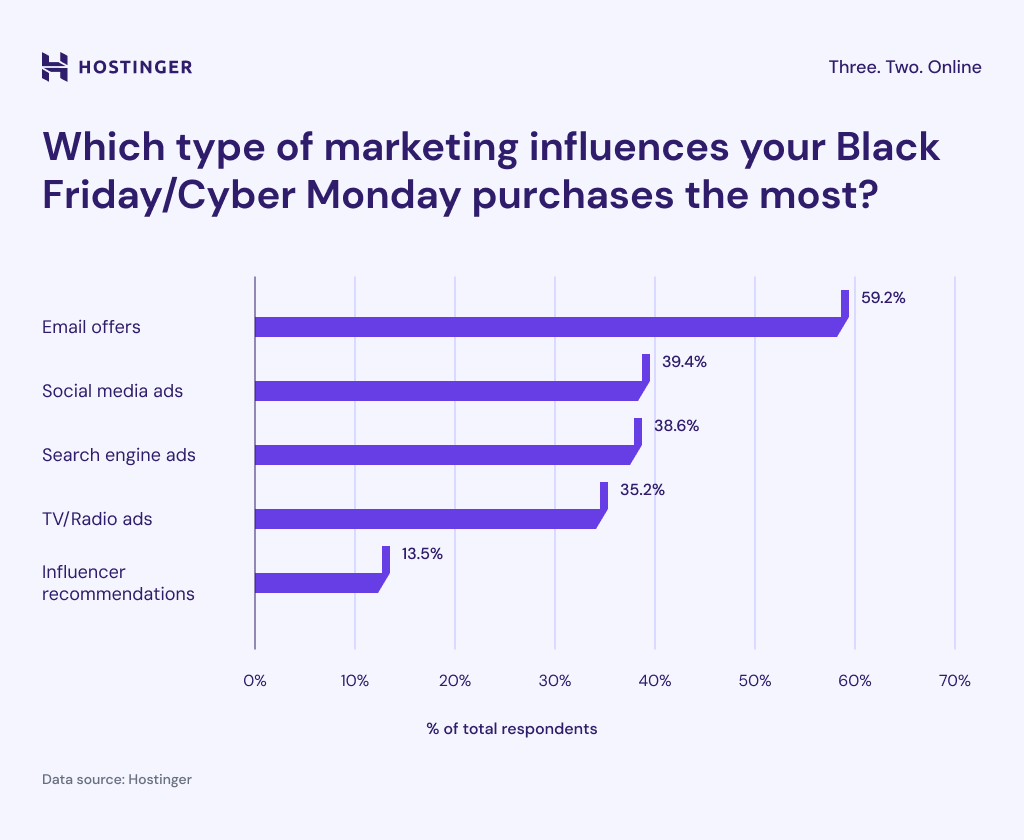
Other Black Friday marketing tactics, like social media ads (39.4%), search engine ads (38.6%), and TV and radio ads (35.2%), trail behind. Interestingly, influencer recommendations are the least effective, impacting only 13.5% of consumers.
Both men and women report email offers as their preferred marketing channel, though women are slightly more responsive to them than men. Men, on the other hand, are more likely to be influenced by TV, radio, and search engine ads compared to women.
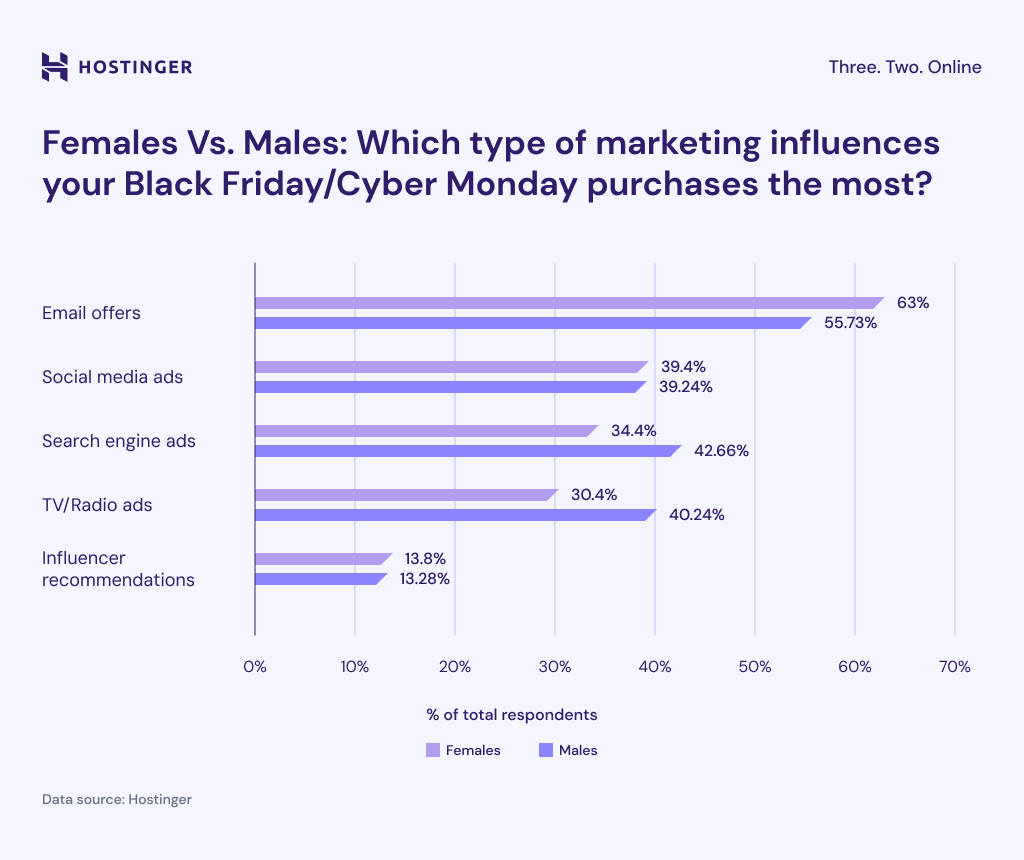
Email offers are also preferred across all generations. However, Gen Z, Millennials, and Gen X are more responsive to social media ads, while older generations, such as Baby Boomers, are slightly more influenced by traditional ads on TV and radio, as well as search engine ads. Influencer recommendations, while relatively ineffective for Gen Z, appear to have more traction with older generations.
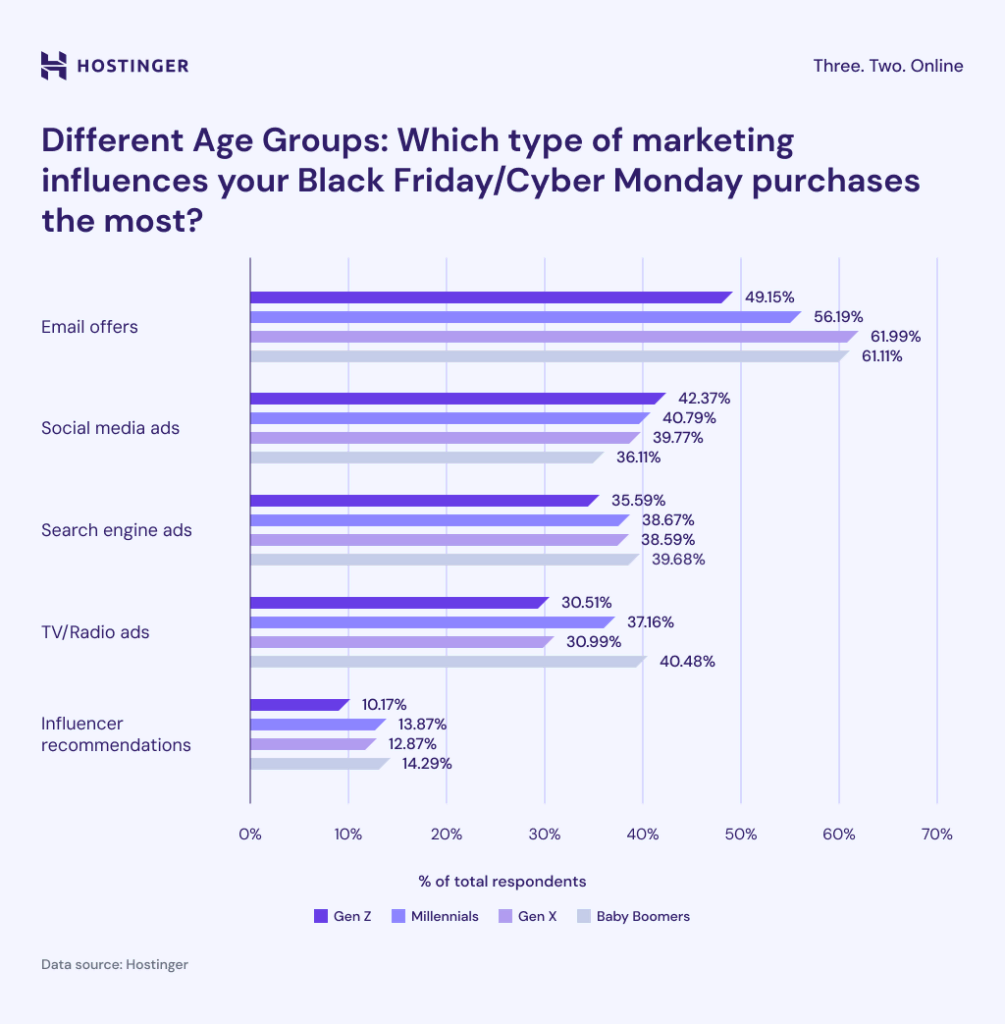
To start improving your email campaigns, learn how to create email newsletters that resonate with your audience.
33% of Americans often buy unplanned items
During Black Friday sales, impulse purchases are common, with 32.6% of respondents admitting they often buy things unplanned. The majority, 44.4%, report that they sometimes make unplanned purchases, while 13.6% say they always buy something they hadn’t intended to. Only 8.7% of shoppers rarely make impulse buys, showing that for most, Black Friday is a time for spontaneous spending.
Women are more impulsive than men
Women appear to be slightly more impulsive shoppers than men, with 15.4% of women saying they always buy unplanned items, compared to 11.87% of men. This suggests that women may be more influenced by tempting deals during Black Friday.
Gen Z: Young and reckless?
When it comes to impulse buying, Gen Z leads the pack. 27.12% of Gen Z respondents admit they always make unplanned purchases during Black Friday, a much higher percentage than 17.22% of Millennials, 13.16% of Gen X, and just 7.14% of Baby Boomers. This highlights Gen Z’s tendency toward more spontaneous spending behavior compared to older generations.
Black Friday excites all genders and generations
When it comes to excitement for Black Friday, Millennials and Gen X lead the way, showing the highest levels of anticipation for the holiday season. However, the enthusiasm for Black Friday spans all age groups, with most respondents rating their excitement above 50 on a scale from 0 to 100.
There are no major differences between genders, as both men and women exhibit similar levels of excitement. Men do tend to cluster more toward the top end of the scale, with many scoring close to 100, while women show a more balanced distribution, with scores ranging from 50 to 95.
Among age groups, Millennials are the most likely to participate in Black Friday or Cyber Monday, with a majority of respondents placing themselves near the top of the scale.
Conclusion
The 2024 Black Friday holiday shopping season is shaping up to be more exciting than ever, with shoppers looking for great deals, faster shipping, and seamless online shopping experiences.
While price remains the top factor influencing purchase decisions, consumers – especially Gen Z – are looking for more than just discounts. They want convenience and speed, with same-day delivery becoming increasingly important.
For retailers, success will come from understanding these preferences and offering what shoppers really want. Whether it’s Baby Boomers buying toys for their grandkids or Millennials shopping for home appliances, knowing what drives different groups can make all the difference.
Email marketing remains the best way to reach most buyers, but don’t forget that social media ads are also gaining ground, especially with younger shoppers.
To stand out, businesses should create personalized deals that appeal to each group. Offering value, convenience, and fast shipping will help turn visitors into buyers and build stronger customer relationships.
